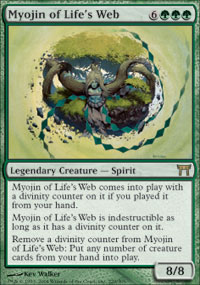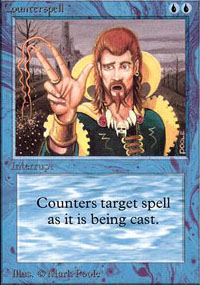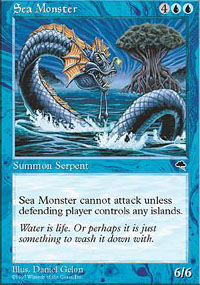
After learning the basics of card advantage and card impact, Timmy and Jimmy have set out to improve their ability to evaluate cards and their decisions during a game. By studying and playing with decks built by better players, they have gained a feel for how decks should go together and why some cards are chosen over others. They still have a long way to go, but they're off to a start at least...

A typical Timmy trap.
Impact, impact, impact. If Timmy and Jimmy know one thing, it's the value of recognizing impact. Impact essentially measures the power of a card, and everyone wants to play with powerful cards. And not just one or two of them, but a whole deck packed with power. Part of successful deckbuilding is maximizing the impact of the cards in your deck.
On the other hand, impact is one of the biggest pitfalls for new players. When starting out, players may become overly attracted to cards with big effects, regardless of the cost. "Scaled Wurm is a 7/6? Awesome!" "This creature lets me put all my other creatures into play for free!!" These players dream of decks filled completely with bombs, so that every card drawn can potentially turn the whole game upside-down.
As players become more experienced, they realize that bigger effects generally come with bigger costs, meaning that there's a tradeoff between impact and playability. So it's not enough just to pack a deck with high-impact cards; the cards need to be reasonably easy to play. They also need to be useful in more than just a handful of situations.
Card Economy
One useful concept for evaluating cards is card economy - just how much can you squeeze out of one card? I'll stick to a simple definition: card economy is the potential impact per card. I use the term "potential impact" because a card may be used in multiple ways. For example, Invoke the Firemind has potential impact either as burn or as a draw spell, but its actual impact in the game will only be one of those.
Card economy is important for two reasons:
1) The number of cards in your deck is limited. You want to keep as close to the minimum deck size as possible because of consistency, but you also want to be able to do a lot with those cards.
2) The number of cards you see in a game is limited. Ideally, you want the total impact of the cards you draw to be greater than the total impact of the cards your opponent draws. This can be achieved by simply drawing more cards, but it can also be achieved by squeezing more impact into your cards.
You might notice that this concept encompasses our earlier concept of versatility (as discussed in Part I and in Part V). As you'll recall, there's an advantage to having cards which can serve multiple different purposes. It means that your cards are useful in a greater number of situations, you get more options, and it helps improve your odds of drawing the right balance of resources, threats, and answers. When analyzing your deck's versatility, you can think of your average card economy by adding up your whole deck's potential impact and dividing by the number of cards. This gives you an idea of what each card drawn can offer. For example, you might have an average card economy where each card is worth 40% of a mana source, 20% of a removal spell, 20% of a draw spell, 33% of a creature threat, and so on. Notice that each card can virtually be worth several full effects.
Reusable cards represent a special type of card economy, since they can theoretically provide an "infinite" amount of impact per card. For example, buyback spells such as Whispers of the Muse let you repeatedly draw cards using the same card, with mana being your only limiting factor. The same is true for recurring cards such as Sosuke's Summons, mechanics like flashback and haunt, and permanents with activated abilities, such as The Hive. In fact, most permanents offer you continuous impact while they're in play - lands keep providing you mana, creatures keep providing you the potential to deal damage, etc.
Obviously, card economy isn't everything, since cards don't usually give us impact for free. This brings us to efficiency.
Efficiency
I've mentioned efficiency before in Part II. I'll give a more formal definition here: the efficiency of a card (or ability) is its impact-to-cost ratio. The cost of a card or ability includes all of the resources required to play it. Some examples:
- Ancestral Recall has an impact of "draw three cards at instant speed" for the cost of
 and one card (the Ancestral Recall). Concentrate has an impact of "draw three cards at sorcery speed" for the cost of :2mana::symu::symu: and one card (the Concentrate). Since they have the same impact (aside from the instant/sorcery difference), we can declare that Ancestral Recall is more efficient than Concentrate due to the lower cost. It is also more efficient than Reach Through Mists (ignoring Arcane triggers and Splice) since it has a greater impact for the same cost.
and one card (the Ancestral Recall). Concentrate has an impact of "draw three cards at sorcery speed" for the cost of :2mana::symu::symu: and one card (the Concentrate). Since they have the same impact (aside from the instant/sorcery difference), we can declare that Ancestral Recall is more efficient than Concentrate due to the lower cost. It is also more efficient than Reach Through Mists (ignoring Arcane triggers and Splice) since it has a greater impact for the same cost. - Lightning Blast has an impact of "deal 4 damage to target creature or player" for the cost of :3mana::symr: and one card. Char essentially has an impact of "deal 4 damage to target creature or player" for the cost of :2mana::symr:, one card, and 2 life. They provide the same impact, but Char costs 1 less mana and 2 more life. Neither one is strictly more efficient than the other, though each may be better under different circumstances.
- Hypnotic Cloud provides two possible effects. One has an impact of "target player discards a card" for the cost of :1mana::symb: and a card, while the other has an impact of "target player discards three cards" for the cost of :5mana::symb: and a card. Mind Peel also gives two possible effects. One has an impact of "target player discards a card" for the cost of
 and a card, while the other has an impact of "target player discards a card" for the cost of :2mana::symb::symb::symb:. The first effect of Hypnotic Cloud is strictly less efficient than the first effect of Mind Peel, but no other pair of these effects can be directly compared.
and a card, while the other has an impact of "target player discards a card" for the cost of :2mana::symb::symb::symb:. The first effect of Hypnotic Cloud is strictly less efficient than the first effect of Mind Peel, but no other pair of these effects can be directly compared.

"Boy, back in my day, two blue mana
got you a hard counter..."
Just as we want our decks to have as much card economy as possible, we also want our decks to be as efficient as possible. But as we saw from some of the examples above, efficiency is sometimes difficult to compare. Is Char better than Lightning Blast? Is that casting cost of one less mana worth the loss of two life? There are no easy answers to questions like this one, but they become easier to approach when you understand the economic nature of Magic.
The game of Magic is not a free market. Players have to work with what Wizards of the Coast gives us, so if they say that a certain effect has a certain price, then so be it. What we have to look at is the baseline cost of different effects in different formats. This is especially true for rotating formats such as Standard or in constrained formats such as Block Constructed. Counterspell once cost only :symu::symu: and a card; now the effect costs at least one mana more and comes with strings attached.
The cardpool of a given format determines the maximum efficiency for any given effect. These limits are useful when studying the capabilities of the cardpool, particularly in terms of resource efficiency, threat efficiency, and answer efficiency. Efficiency in resource conversion is also important to examine, as that affects how we compare two different things. Ultimately, these efficiencies are some of the defining characteristics of any format, influencing what strategies are and are not viable.
Analyzing the economy of a cardpool is far beyond the scope of this article, but we'll come back to it bit by bit as we continue in this series. For now, just understand that comparing efficiencies generally depends on the rest of the cardpool.
Synergy
Instead of looking at the context of a entire cardpool, let's focus on aspects of card economy and efficiency that involve the interaction between cards. Timmy and Jimmy have learned the basics of card economy and efficiency, but so far they've been limited mostly to a vacuum. What happens when we put cards together? Can't we make combos that will give a net impact greater than the impacts of the individual cards? Sure! This is what we call synergy.
The basic definition of synergy is this: synergy is an interaction among cards and/or abilities that increases card economy and/or efficiency. Remember that card economy is the "potential impact per card"; we can increase this by giving a card more potential impact. Meanwhile, efficiency is the "impact-to-cost ratio," so this can be improved by either increasing impact or by decreasing cost. Here are some examples:
- Cloudstone Curio has synergy with creatures that have "comes into play" effects (e.g. Ravenous Rats) because it increases card economy. We can now get multiple uses of a particular effect from just a single card.
- Furnace of Rath doubles the impact of Lightning Bolt, so that increases both card economy and efficiency.
- Djinn Illuminatus has synergy with any instant or sorcery by increasing card economy, even though it doesn't increase efficiency (since the cost varies directly with the impact).
- Long-Forgotten Gohei increases the efficiency of most Arcane spells by reducing their costs, and also increases the card economy and efficiency of Spirits by boosting their impact.
- Greater Good has synergy with creatures, since it increases their potential impact. You can now get an additional effect out of each creature, even if the creature is about to die.
- Seismic Assault has synergy with land cards, giving each of them more potential impact.
- A Genesis in your graveyard has synergy with your creature cards, giving you a way to reuse creatures after they die. This gives you more potential impact for each of those cards.
Be aware that there is such a thing as negative synergy: when cards and abilities interact in a way such that it decreases card economy or efficiency, then you have negative synergy. Ideally, you want to avoid negative synergy among cards in your deck while maximizing positive synergy, since that provides you with the greatest total impact. Decks such as Mirrodin-block Raffinity contain so much synergy that almost any two cards in the deck will combine to produce a net impact gain, while no two cards have negative synergy.

Wow, this card sucks.
It is important to distinguish between synergy and dependency. A dependency of a card or ability is anything required for that card or ability to have impact. For example, the relationship between Unholy Strength and creatures is one of dependency, not synergy. Without a creature in play, the Unholy Strength has no impact. Thus, it is dependent on having a creature in play. Some other examples of dependencies include Coalition Victory, Epic Struggle, the second abilities of the tainted lands, and Sea Monster.
On a more abstract level, all costs translate into dependencies. Your 3-drops require you to have sources for three mana of the appropriate color, for example. The same applies to any other spell in your deck with a nonzero converted mana cost. Because of this, all decks are fundamentally dependent on lands, which is the reason that land destruction can be a viable strategy (remember the discussion on virtual card advantage last time?). Essentially, attacking a deck's dependencies is like attacking the bottom level of a house of cards.
As demonstrated by the land destruction example, dependency is strongly tied to virtual card advantage. Since a dependent card has zero impact until its dependencies have been fulfilled, that card can be considered dead. I mentioned that one form of virtual card advantage occurs when one player draws an answer that has no appropriate target. Treating this as a form of dependency, you can see that Dark Banishing is dependent on your opponent having a nonblack creature. If she's playing Suicide Black, then you're out of luck.
Cards with dependencies are sometimes called "situational," since their usefulness depends heavily on the situation. Spells like Dark Banishing won't always be useful, not to mention even narrower spells such as Hidetsugu's Second Rite or Squelch. Keeping this in mind gives us another question to ask when evaluating a card's impact: when does this card have impact?
This question covers more than just very dependent cards. For any card in your deck, you want to identify its potential impact at each stage of the game. What can this card do in the early game? What about the middle game? The late game? Some cards will only have real impact in the first few turns, while others aren't even playable until several turns later. Keep in mind that the card's impact may also depend on the particular strategy of your deck, or on the interaction between two strategies in a given matchup.
An Overview of Impact
We've seen that there are several basic factors needed for evaluating the impact of a card. If we phrased them as questions, they would be:
- How much impact can I get from this one card? (card economy)
- How much does this impact cost, especially compared to other cards? (efficiency)
- How does this affect the impact of other cards? (synergy)
- What does this card require to have impact? (dependency)
- During which stages of the game does this card have impact?
Although these aren't the only criteria for judging a card, they are a very good start. Timmy and Jimmy have learned a lot about card selection by applying these questions to the decks they build and study. They start to see why some decks work better than others, and it's not just due to having broken cards. Decks tend to work better when they have high card economy, high efficiency, high synergy (and low negative synergy), and low dependency. They also do well when the cards are useful at times that are appropriate for the deck's strategy. Cards aren't just thrown in because they are good cards individually; they have to fit into the context of the deck.
The last question above, regarding the issue of when a card has impact, is one that requires much more examination. A card's usefulness is a dynamic trait that can change drastically from turn to turn. In the next part of the series, we'll turn our eye to exploring this issue, focusing on the timeline of a typical game and re-examining critical turns and tempo. Make sure you don't miss out!
-fadeblue
Comments